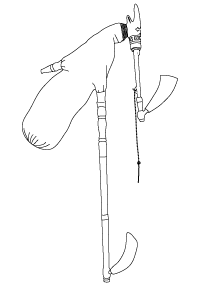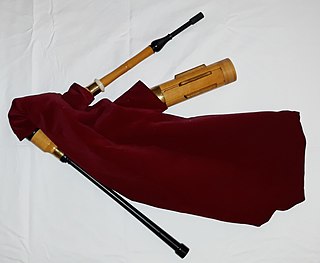
Bagpipes are a woodwind instrument using enclosed reeds fed from a constant reservoir of air in the form of a bag. The Great Highland bagpipes are well known, but people have played bagpipes for centuries throughout large parts of Europe, Northern Africa, Western Asia, around the Persian Gulf and northern parts of South Asia.

The uilleann pipes, also known as Union pipes and sometimes called Irish pipes, are the characteristic national bagpipe of Ireland. Their current name is a partial translation of the Irish language terms píobaí uilleann, from their method of inflation. There is no historical record of the name or use of the term uilleann pipes before the 20th century. It was an invention of Grattan Flood and the name stuck. People mistook the term 'union' to refer to the 1800 Act of Union; however, this is incorrect as Breandán Breathnach points out that a poem published in 1796 uses the term 'union'.

The chanter is the part of the bagpipe upon which the player creates the melody. It consists of a number of finger-holes, and in its simpler forms looks similar to a recorder. On more elaborate bagpipes, such as the Northumbrian bagpipes or the Uilleann pipes, it also may have a number of keys, to increase the instrument's range and/or the number of keys it can play in. Like the rest of the bagpipe, they are often decorated with a variety of substances, including metal (silver/nickel/gold/brass), bone, ivory, or plastic mountings.

The great Highland bagpipe is a type of bagpipe native to Scotland, and the Scottish analogue to the great Irish warpipes. It has acquired widespread recognition through its usage in the British military and in pipe bands throughout the world.

The border pipes are a type of bagpipe related to the Scottish Great Highland Bagpipe. It is perhaps confusable with the Scottish smallpipe, although it is a quite different and much older instrument. Although most modern Border pipes are closely modelled on similar historic instruments, the modern Scottish smallpipes are a modern reinvention, inspired by historic instruments but largely based on Northumbrian smallpipes in their construction.

Swedish bagpipes are a variety of bagpipes from Sweden. The term itself generically translates to "bagpipes" in Swedish, but is used in English to describe the specifically Swedish bagpipe from the Dalarna region.

Zampogna is a generic term for a number of Italian double chantered bagpipes that can be found as far north as the southern part of the Marche, throughout areas in Abruzzo, Latium, Molise, Basilicata, Campania, Calabria, Apulia and Sicily. The tradition is now mostly associated with Christmas, and the most famous Italian carol, "Tu scendi dalle stelle" is derived from traditional zampogna music. However, there is an ongoing resurgence of the instrument in secular use seen with the increasing number of folk music festivals and folk music ensembles.
A Koza is the generic term for one of five basic types of bagpipes used in Polish folk music. The koza comes from the southern mountainous region of Poland known as Podhale and differs considerably from other types of bagpipes in its construction. Its scale is: b,c,d,e,f,g. The instrument is known for producing a continuous, low pitch.
The term double clarinet refers to any of several woodwind instruments consisting of two parallel pipes made of cane, bird bone, or metal, played simultaneously, with a single reed for each. Commonly, there are five or six tone holes in each pipe, or holes in only one pipe while the other acts as a drone, and the reeds are either cut from the body of the instrument or created by inserting smaller, slit tubes into the ends of the pipes. The player typically uses circular breathing.

The Hungarian duda is the traditional bagpipe of Hungary. It is an example of a group of bagpipes called Medio-Carparthian bagpipes.

Kokle or historically kokles (kūkles) is a Latvian plucked string instrument (chordophone) belonging to the Baltic box zither family known as the Baltic psaltery along with Lithuanian kanklės, Estonian kannel, Finnish kantele, and Russian krylovidnye gusli. The first possible kokles related archaeological findings in the territory of modern Latvia are from the 13th century, while the first reliable written information about kokles playing comes from the beginning of the 17th century. The first known kokles tune was notated in 1891, but the first kokles recordings into gramophone records and movies were made in the 1930s. Both kokles and kokles playing are included in the Latvian Culture Canon.

The torupill is a traditional bagpipe from Estonia.
This article defines a number of terms that are exclusive, or whose meaning is exclusive, to piping and pipers.
The volynka is a bagpipe. Its etymology comes from the region Volyn, Ukraine, where it was borrowed from Romania.

The gudastviri is a droneless, double-chantered, horn-belled bagpipe played in Georgia. The term comes from the words guda (bag) and stviri (whistling). In some regions, the instrument is called the chiboni, stviri, or tulumi.

The gaita de boto is a type of bagpipe native to the Aragon region of northern Spain.

Irish warpipes are an Irish analogue of the Scottish great Highland bagpipe. "Warpipes" is originally an English term. The first use of the Gaelic term in Ireland was recorded in a poem by Seán Ó Neachtain, in which the bagpipes are referred to as píb mhór.

Dūdmaišis or Labonoro dūda is a Lithuanian bagpipe with a single chanter and drone. The Lithuanian bagpipe was traditionally played at a variety of events, including May Day festivities, and spring caroling. A 1955 publication by the Lituanus Foundation noted that: "The Labanoro Dūda or Bagpipe was at one time very widely used, though it is almost forgotten."

Shuttle pipes are a type of bagpipes which derive their name from the drones used to produce the harmony. Rather than the long tube-like drones of most bagpipes, shuttle pipes use a shuttle drone, a cylindrical chamber enclosing a series of folded drone tubes, each terminating in a slot covered by a sliding "shuttle" which can be adjusted to lengthen or shorten the distance traveled by air moving through the tube, thus flattening or sharpening the pitch of the note produced.














